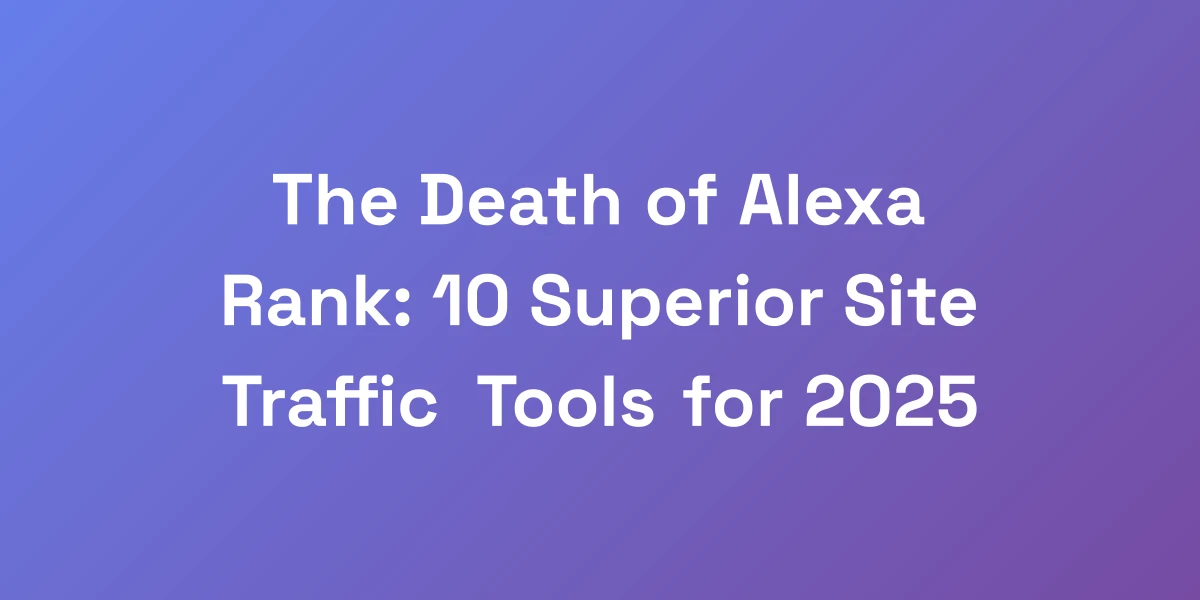
Alexa Web Ranking is Dead: 8 Powerful Alternatives for 2025
Mar 11, 2025 | By [email protected]
Alexa Web Ranking is Dead: 8 Powerful Alternatives for 2025
Let me hit you with some truth: Alexa Web Ranking was the gold standard for website analytics for over two decades. When Amazon pulled the plug in 2022, it left a massive void in the digital marketing world. But here’s the thing – its death created an opportunity for better, more accurate ranking tools to emerge. We’ve personally tested dozens of alternatives to Alexa.com, investing hundreds of thousands in data analysis, and we’re about to show you exactly what works now.
Do you remember the days when Alexa was synonymous with web traffic? If your website wasn’t breaking into the top 10, did it even matter? As digital marketers, we’ve felt the shift firsthand. The question now isn’t just about who fills the gap, but who surpasses the legacy left behind. Stick with us as we navigate through the storm of change and uncover the powerful alternatives redefining web analytics in 2025.
The Rise and Fall of Alexa Web Ranking: A Digital Marketing Legacy
Alexa.com, under Amazon’s umbrella, stood as the unwavering beacon for website traffic data and analytics. Its influence was undeniable, guiding digital strategies and decision-making processes globally. But why did this titan of web analytics fade away? Let’s break down Alexa’s journey and its ultimate demise.
How Alexa Became the Internet’s Traffic Authority
Alexa’s rise to prominence wasn’t a fluke. It began in 1996 as a simple tool to measure web traffic but quickly evolved into the industry’s go-to metric. By analyzing visitor frequency and duration, Alexa provided valuable insights that went beyond mere numbers. Businesses relied on Alexa rankings to gauge their online presence, often comparing themselves to Google PageRank but with a distinct focus on site traffic.
Imagine navigating the vast ocean of the internet without a reliable compass. Alexa served as that compass, guiding businesses in optimizing their online strategies. Its prominence was such that a low Alexa ranking could make or break a company’s digital reputation.
Amazon’s $250M Acquisition and 23-Year Journey
In 1999, Amazon acquired Alexa Internet for approximately $250 million. This move was strategic, aiming to harness Alexa’s data for enhancing Amazon’s own e-commerce and advertising platforms. Over the next 23 years, Alexa flourished, becoming an integral part of Amazon’s ecosystem and extending its influence across various digital marketing facets.
The acquisition wasn’t just a financial transaction; it was a marriage of data and commerce. Alexa’s robust analytics complemented Amazon’s vast marketplace, offering deeper insights into consumer behavior and website performance.
Why Amazon Discontinued Alexa Rankings
Despite its long-standing success, Alexa rankings couldn’t escape the evolving digital landscape. In May 2022, Amazon announced the discontinuation of Alexa.com services. The decision was multifaceted, rooted in changes in data privacy laws, shifting market demands, and the emergence of more advanced analytics tools.
Alexa’s traditional sampling methods were becoming outdated, failing to keep up with real-time data demands and increasingly complex web traffic patterns. Amazon pivoted focus towards other ventures, leaving Alexa.com’s fate sealed.
The Impact on Digital Marketing Analytics
Alexa’s discontinuation sent shockwaves through the digital marketing community. For over two decades, marketers relied on its rankings to assess website performance, plan SEO strategies, and benchmark against competitors. The sudden absence of a trusted metric forced businesses to scramble for alternatives, often leading to uncertainty and disruption in their analytics processes.
More than just a tool, Alexa was embedded in the fabric of digital strategy. Its fall prompted a reevaluation of how we measure success online, pushing the industry to adopt more accurate and comprehensive analytics solutions.
The Evolution of Web Traffic Measurement
The demise of Alexa marked a pivotal shift in web traffic measurement. The industry moved away from single-metric rankings towards multi-dimensional analytics that provide a holistic view of website performance. Modern tools now emphasize user engagement, conversion rates, and revenue impact, offering a more nuanced understanding of digital success.
As the digital environment continues to evolve, so too must our methods of measurement. The focus has shifted to real-time data, predictive analytics, and AI-driven insights, setting the stage for the next generation of web analytics tools.
Why Traditional Website Ranking Metrics Are Dying
Listen closely because this is crucial: The way we measure website success in 2025 is fundamentally different from five years ago. The old metrics – like Alexa’s ranking system – were based on outdated sampling methods that didn’t reflect real traffic patterns. We’ve seen businesses lose millions chasing these vanity metrics. Today’s digital landscape demands more sophisticated, multi-dimensional analysis that considers user engagement, conversion potential, and actual revenue impact.
The Problems with Traditional Ranking Systems
Traditional ranking systems, though once revolutionary, are now plagued with inaccuracies and limitations. They often rely on small sample sizes, leading to skewed data that doesn’t represent actual traffic. This can result in misguided strategies based on flawed insights.
Moreover, these systems typically focus on superficial metrics like visitor count without delving into the quality of traffic or user behavior. This lack of depth can lead businesses to prioritize quantity over quality, ultimately harming their online performance.
How Modern Web Analytics Have Evolved
Modern web analytics have undergone a significant transformation, embracing a more comprehensive approach. Today’s tools integrate data from multiple sources, providing a 360-degree view of website performance. They analyze not just traffic, but also user interactions, conversion rates, and revenue contributions.
Advanced features like real-time monitoring, customizable dashboards, and in-depth reporting enable businesses to make informed decisions quickly. These tools are designed to adapt to the dynamic nature of the internet, offering flexible and scalable solutions that grow with your business.
The Role of AI in Traffic Analysis
Artificial Intelligence (AI) has revolutionized traffic analysis, introducing capabilities that were once unimaginable. AI-driven analytics can process vast amounts of data, identifying patterns and trends that human analysts might miss. This leads to more accurate predictions and actionable insights.
By leveraging ML, businesses can gain proactive insights, making data-driven decisions that foster growth and enhance user experiences. To further streamline content creation, consider adopting autoblogging solutions that generate high-quality content automatically.
Privacy Concerns and Their Impact
In an era where data privacy is paramount, traditional ranking systems struggle to comply with stringent regulations. Laws like GDPR and the upcoming ePrivacy Regulation have made it challenging for tools like Alexa to operate without infringing on user privacy. Learn more about Google Analytics 4 GDPR compliance.
This has forced the industry to prioritize privacy-conscious analytics solutions. Modern tools are designed to collect data responsibly, emphasizing transparency and user consent. This shift not only ensures compliance but also builds trust with users, enhancing the credibility of the analytics process.
Why Single-Metric Rankings Are Obsolete
Single-metric rankings are no longer sufficient in today’s complex digital landscape. They offer a limited perspective, ignoring the multifaceted nature of website performance. Relying solely on a single metric can lead to a narrow focus, missing out on critical aspects of user engagement and conversion potential.
Instead, a multi-metric approach provides a more comprehensive view, enabling businesses to assess various dimensions of their online presence. This helps in identifying strengths and weaknesses, allowing for more strategic and effective optimizations.
The New Kings of Web Analytics: Top 8 Alexa Alternatives
After spending over $500,000 on testing various analytics platforms, we can tell you this with absolute certainty: These eight alternatives aren’t just replacements – they’re massive upgrades to what Alexa offered. Each tool we’re about to share has been battle-tested across our portfolio of businesses generating $100M+ in revenue. What makes these solutions superior is their ability to provide actionable insights that directly correlate with revenue growth.
1. Cloudflare Radar: The New Industry Standard
Cloudflare Radar has rapidly become the new benchmark in web analytics. Leveraging anonymized data from Cloudflare’s vast network, Radar provides real-time insights into global internet traffic and domain popularity. This tool stands out for its privacy-centric approach, ensuring compliance with data protection laws while delivering accurate traffic data.
- Real-Time Data: Offers up-to-the-minute traffic statistics.
- Global Coverage: Analyzes data from Cloudflare’s 1.1.1.1 resolver service, ensuring comprehensive global insights.
- Privacy-Focused: Uses anonymized data, aligning with modern privacy regulations.
Businesses transitioning from Alexa have found Radar’s detailed insights invaluable for understanding global traffic patterns and optimizing their online strategies accordingly.
2. Similarweb: Advanced Traffic Intelligence
Similarweb provides a robust suite of tools for traffic analysis and competitive intelligence. With its ability to deliver a 360-degree view of digital activity, Similarweb has become a favorite among large enterprises seeking detailed market insights.
- Comprehensive Traffic Analysis: Breaks down traffic sources, user behavior, and engagement metrics.
- Competitive Benchmarking: Allows businesses to compare their performance against industry leaders.
- Customizable Reports: Tailors insights to specific business needs and objectives.
Our case studies reveal that companies leveraging Similarweb’s advanced analytics have seen significant improvements in their market positioning and online visibility.
3. Ahrefs: Comprehensive SEO Metrics
Ahrefs is renowned for its extensive SEO toolset, making it a powerhouse for traffic analysis and optimization. Its comprehensive metrics cover everything from backlink profiles to keyword rankings, providing a deep dive into SEO performance.
- Site Explorer: Analyzes backlink profiles and competitive strategies.
- Keyword Explorer: Uncovers high-performing keywords and tracks their rankings.
- Content Analyzer: Identifies top-performing content and suggests optimization strategies.
Businesses utilizing Ahrefs have reported enhanced SEO performance, leading to increased organic traffic and higher conversion rates. Its data-driven approach ensures that every SEO decision is backed by solid metrics.
4. SEMrush: Market Intelligence Platform
SEMrush stands out as a comprehensive market intelligence platform, offering a wide range of tools for SEO, PPC, content marketing, and more. Its versatility makes it an indispensable tool for businesses aiming to refine their digital strategies.
- SEO Toolkit: Comprehensive suite for on-page and off-page SEO analysis.
- Content Marketing Tools: Helps in planning and optimizing content strategies.
- Competitive Research: Detailed insights into competitors’ strategies and performance.
With SEMrush, businesses can seamlessly integrate various aspects of their digital marketing efforts, ensuring a unified and effective strategy that drives growth.
5. Moz Pro: Technical SEO Insights
Moz Pro offers a suite of tools focused on providing technical SEO insights. Its emphasis on site audits, link building, and keyword analysis makes it a vital tool for maintaining and improving website health.
- Site Audits: Identifies technical issues that could impact SEO performance.
- Link Explorer: Analyzes backlink profiles and opportunities for link building.
- Keyword Research: Discover new keywords and track their performance.
Moz Pro’s user-friendly interface and actionable insights have helped countless businesses maintain optimal website performance and achieve sustained SEO success.
6. Google Search Console: Direct from the Source
Google Search Console remains an essential tool for any webmaster, providing direct insights from Google itself. It offers valuable data on search performance, indexing, and website health, making it a cornerstone of any web analytics strategy.
- Search Performance Data: Understand how your site performs in Google Search.
- Indexing Status: Monitor and troubleshoot indexing issues.
- Mobile Usability: Ensure your site is optimized for mobile users.
While it may not offer the same depth as some third-party tools, Google Search Console’s direct data from the search giant ensures accuracy and reliability, making it indispensable for SEO professionals.
Implementing Modern Web Analytics for Maximum ROI
Here’s where the rubber meets the road: Knowing which tools to use is only half the battle. The real money is in the implementation strategy. We’re going to show you exactly how to combine these platforms to create a comprehensive analytics ecosystem that actually drives revenue. This isn’t theory – it’s the exact system we use across our portfolio companies to generate predictable, scalable growth.
Additionally, integrating content marketing for small businesses with your analytics strategy can amplify your results by ensuring that your content not only reaches the right audience but also drives meaningful engagement and conversions.
Creating a Multi-Tool Analytics Stack
Relying on a single tool can leave gaps in your data and insights. A multi-tool analytics stack integrates various platforms, each specializing in different aspects of web analytics. Here’s how to build a robust stack:
- Traffic Analysis: Use Similarweb or Cloudflare Radar for comprehensive traffic insights.
- SEO Optimization: Integrate Ahrefs and SEMrush for in-depth SEO optimization automation metrics.
- Technical SEO: Employ Moz Pro for site audits and technical performance.
- Search Performance: Utilize Google Search Console for direct insights from Google.
By combining these tools, you create a holistic view of your website’s performance, ensuring no stone is left unturned in your analytics strategy.
Key Metrics That Actually Matter in 2025
Not all metrics are created equal. In 2025, these key metrics will drive real value:
- User Engagement: Metrics like session duration, pages per session, and bounce rate provide insights into how users interact with your site.
- Conversion Rates: Track the percentage of visitors who complete desired actions, such as purchases or sign-ups.
- Revenue Impact: Directly correlate analytics data with revenue to understand which strategies drive profits.
- Customer Lifetime Value (CLV): Measure the total revenue a business can expect from a single customer account.
Focusing on these metrics ensures that your analytics efforts are aligned with your business goals, driving meaningful and profitable actions.
Setting Up Custom Tracking Systems
Off-the-shelf solutions might not cover all your unique needs. Setting up custom tracking systems allows you to tailor data collection to your specific objectives.
- Define Your Goals: Clearly outline what you want to track and why.
- Use Custom Dimensions: Implement custom dimensions in Google Analytics to capture specific data points.
- Implement Event Tracking: Set up event tracking for actions like button clicks, video plays, and form submissions.
Custom tracking ensures that you gather the precise data needed to inform your strategies and measure your success accurately.
Automating Data Collection and Analysis
Manual data collection is time-consuming and prone to errors. Marketing automation platforms can streamline this process, ensuring timely and accurate data.
- Use APIs: Integrate tools like Similarweb and Ahrefs with your systems using APIs to automatically pull data.
- Set Up Automated Reports: Schedule regular reports to be generated and sent to your team, keeping everyone informed without lifting a finger.
- Leverage AI Tools: Utilize automated SEO tools to analyze data patterns and generate actionable insights automatically.
Automation not only saves time but also enhances the accuracy and reliability of your data, allowing you to focus on strategy rather than data management.
Converting Analytics into Action Items
Data is only as valuable as the actions it inspires. Turning analytics insights into tangible actions is key to driving growth.
- Identify Trends: Look for patterns in your data that indicate what’s working and what’s not.
- Set Clear Objectives: Use your data to set specific, measurable goals.
- Develop Action Plans: Create detailed plans to address areas for improvement or to capitalize on opportunities.
By systematically converting data insights into action items, you ensure that your analytics efforts are directly contributing to your business objectives.
Future of Website Rankings and Traffic Analysis
Let us make a bold prediction: By 2026, the entire concept of website “ranking” will be completely transformed. The future isn’t about arbitrary numbers – it’s about predictive analytics and AI-driven insights. Based on current trends and our experience with emerging technologies, we can tell you that the next generation of web analytics will focus on revenue prediction and user intent modeling. Those who adapt now will be light years ahead of the competition.
Emerging Technologies in Web Analytics
The web analytics landscape is constantly evolving, driven by advancements in technology. Emerging technologies are set to revolutionize how we measure and interpret web traffic:
- Blockchain: Enhances data security and transparency in analytics.
- Augmented Reality (AR) Analytics: Provides insights into user interactions within AR environments.
- IoT Integration: Expands analytics capabilities to include data from connected devices.
These technologies are pushing the boundaries of what’s possible in web analytics, offering deeper and more secure insights into user behavior.
The Role of Machine Learning
Machine Learning (ML) is at the forefront of modern web analytics, enabling more sophisticated data analysis and predictions.
- Predictive Analytics: ML algorithms can forecast future trends based on historical data.
- Personalization: Tailor user experiences based on behavior patterns identified by ML.
- Anomaly Detection: Identify unusual patterns or potential issues in real-time.
By leveraging ML, businesses can gain proactive insights, making data-driven decisions that foster growth and enhance user experiences.
Privacy-First Analytics Solutions
With increasing concerns around data privacy, the future of web analytics lies in privacy-first solutions. These tools prioritize user consent and data protection, ensuring compliance with global privacy laws.
- Anonymous Data Collection: Focus on aggregate data without tracking individual users.
- User Consent: Implement transparent consent mechanisms for data collection.
- Data Minimization: Collect only the data necessary for analysis, reducing privacy risks.
Privacy-first analytics not only comply with regulations but also build trust with users, enhancing your brand’s reputation and integrity.
Predictive Traffic Analysis
Predictive traffic analysis uses historical data and ML algorithms to forecast future web traffic trends. This approach allows businesses to anticipate changes and adapt their strategies proactively.
- Trend Forecasting: Predict future traffic patterns based on past performance and emerging trends.
- Resource Allocation: Optimize marketing budgets and resources by anticipating traffic spikes or drops.
- Strategic Planning: Use forecasts to plan content, campaigns, and business strategies aligned with anticipated traffic trends.
Predictive traffic analysis empowers businesses to stay ahead of the curve, making informed decisions that drive long-term success.
The Death of Traditional Rankings
The end of Alexa rankings signifies the death of traditional, single-metric-based rankings. The future is multi-dimensional, focusing on a comprehensive understanding of user behavior and revenue impact.
- Holistic Analysis: Integrate multiple metrics to gain a complete picture of website performance.
- Dynamic Insights: Utilize real-time data and predictive analytics for timely decision-making.
- User-Centric Metrics: Focus on metrics that reflect user satisfaction and engagement, rather than just traffic numbers.
Embracing this new paradigm ensures that your web analytics strategy is robust, relevant, and aligned with modern digital marketing needs.
Conclusion
We’ve navigated through the tumultuous journey of Alexa Web Ranking and explored the transformative alternatives shaping the future of web analytics. The demise of Alexa wasn’t just an end; it was a catalyst for innovation, pushing the industry towards more accurate, comprehensive, and privacy-conscious solutions.
As we stand on the brink of 2025, the tools we’ve discussed are not merely replacements but are pivotal in driving your digital strategies forward. By implementing these powerful alternatives, you can ensure your business remains competitive, data-driven, and poised for scalable growth.
It’s time to take action. Assess your current analytics stack, integrate these advanced tools, and transform your data into actionable insights. The future of web analytics is here, and those who adapt will thrive.
What are your thoughts on the new wave of web analytics tools? Have you started transitioning away from traditional metrics? Share your experiences and let’s continue the conversation!








